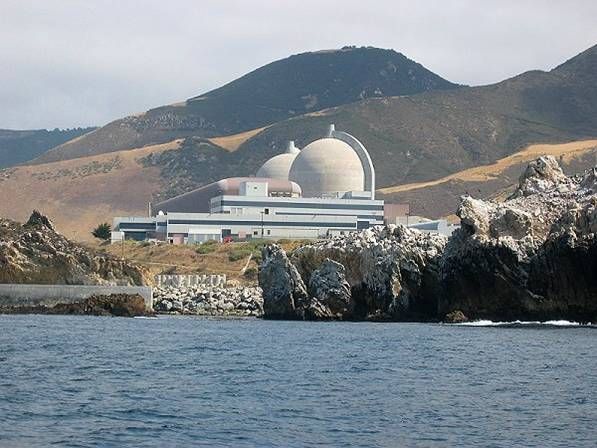PG&E: Jump Start Nuke Power License
By KATY GRIMES
Pacific Gas & Electric appears to be rushing to relicense the Diablo Canyon Nuclear Power plant 13 years before the current license even expires. Many are asking: Why the big rush?
PG&E is under a spotlight of scrutiny about the safety of the facility, particularly after the recent earthquake and tsunami in Japan caused major radioactive leakage at the Fukushima nuclear power plants.
Current licenses for reactors at its two nuclear plants are valid through 2024 and 2025. The latest license application would allow the Diablo Canyon plant to operate until 2045.
At a special state Senate hearing on Monday to address California’s earthquake and disaster preparedness, Sen. Sam Blakeslee, R-San Luis Obispo, asked PG&E representatives to withdraw the early application for license renewal until a seismic study of the site can be done.
Blakeslee has a history with PG&E. Educated and trained as a geophysicist, right after being elected to the Assembly in 2005, Blakeslee wrote an opinion editorial warning about the significant seismic activity around the Diablo Canyon plant. He asked if the facility was safe from tsunami and earthquake damage.
Despite his request for an independent study to determine the seismic activity, Blakeslee said PG&E’s vice president also wrote an op-ed in response — which mocked Blakeslee.
Blakeslee discussed the controversy in a March 20 op-ed in the Santa Cruz Sentinel.
Assembly Bill 1632
Frustrated with PG&E for making light of his concerns over safety, Blakeslee authored AB 1632, a bill requiring the California Energy Commission to assess the vulnerability of California’s aging nuclear power plants. In 2006, it was passed by the Legislature and signed into law by Gov. Arnold Schwarzenegger.
“I’m concerned mostly about this culture of disregard of risk. It’s potentially putting my constituents in a place of great risk,” Blakeslee said at Monday’s hearing.
The hearing covered the impact the Japanese earthquake could have on California, and what if any additional preparations the state needs to be aware of regarding nuclear power plant safety.
If the Japanese earthquake and tsunami has shown the the United States anything, it’s that regulatory agencies seem to be overly sensitive to small, daily risks, and ill-prepared for large-scale risks.
Three panels presented information to the senators and gave an overview of California’s risk of an earthquake and tsunami like Japan just experienced, the potential impact to California, and whether California’s nuclear power plants are safe.
California Energy Commissioner James Boyd, also a liaison officer to the U.S. Nuclear Regulatory Commission, told the Senate committee that the CEC has no regulatory authority over either of California’s nuclear plants. But the energy commission was authorized to oversee the disposal of spent nuclear fuel at existing or new nuclear plants in the state, and coordinates the state’s response to federal proposals for spent fuel transportation, disposal and reprocessing.
And AB 1632 directed the CEC to conduct an assessment of both Diablo Canyon and San Onofre nuclear plants to determine what vulnerabilities there are due to earthquakes, any aging effects of the plants, the impacts of the accumulation of nuclear waste at the locations, and what role nuclear power plays in California.
Boyd presented a list of recommendations surrounding seismic issues at the plants, and strongly recommended additional studies before PG&E’s licensing is granted.
Boyd said that both the San Onofre and Diablo Canyon nuclear plants are older power plants like the compromised Japanese plants, and need to address the future of spent fuel storage. The spent fuel is currently kept on site because the federal government never followed through on plans to build a spent fuel storage station.
In November 2008, Boyd had recommended that both plants have three-dimensional seismic mapping of the area done. But, he said, this has not occurred.
PG&E: “No concern.”
“We believe there is no uncertainty in the Diablo Canyon site,” said Lloyd Cluff, PG&E’s director of earthquake risk management. When pushed to explain, Cluff said, “There’s uncertainty in everything we do. But we have no concern.”
PG&E has received heavy criticism in recent years when it was discovered that valves in the coolers had been stuck shut for nearly 18 months at the Diablo Canyon plant. But Steve David, the site director at Diablo Canyon, told the committee that the backup systems were operational, and there were other cooling-water sources available.
“Are you saying nothing bad will happen?” asked Sen. Elaine Alquist, whose district includes San Bruno, the location of the PG&E gas explosion that ripped through a neighborhood, destroying nearly 40 homes and killing four people.
“I just don’t find PG&E truly forthcoming in addressing these issues,” Alquist said.
Diablo Canyon has not been without controversy. More than one year after obtaining licensing and construction permits, the Hosgri Fault was discovered, with the capability of producing a 7.5 magnitude earthquake.
David Hirsch, a lecturer at the University of California, Santa Cruz, told the committee that what started as a $360 million nuclear power plant became a $5.7 billion plant, with additional and unplanned seismic retrofits costing the bulk of the additional construction costs. Hirsch attributed the unplanned seismic retrofit costs to a permitting vote, which PG&E had heavily objected to beforehand. He told committee members that PG&E had been successful since the 1960’s at preventing in-depth studies of the consequences of an earthquake at the Diablo Canyon plant, located on the Central Coast.
And then adding insult to injury, the blueprints for the plan were misread, and construction done incorrectly, leading to a rebuild.
Two years ago, another fault was discovered near the plant called the Shoreline Fault. PG&E and the Nuclear Regulatory Commission determined that the plant could survive an earthquake on the fault.
“Given that the license doesn’t expire until 2024-25,” said Blakeslee, “licensing should be in the hands of the CEC.” Blakeslee said that unless PG&E suspends or withdraws its licensing application, he will be “pursuing legislation,” adding “there’s more than enough time to address this.”
Alquist agreed with Blakeslee and said she wanted to take it a step further. “I don’t want to wait until 2024-25,” she said. “I think something needs to be done, or horrible things can happen.”
Related Articles
GOP’s Texas-California connection grows
If present trends continue, California Republicans could set up a virtual government-in-exile in Texas. As is now well known, outmigration from
CARB Dumps On Dump Truck Industry
FEB. 23, 2011 For Lee Brown, who’s run a dump truck company in Upland for the last 20 years, business
2nd Amendment groups fight CA gun-control laws in court
As fast as California lawmakers can write new gun-control laws, Second Amendment groups are challenging them in court. buy definition essay





